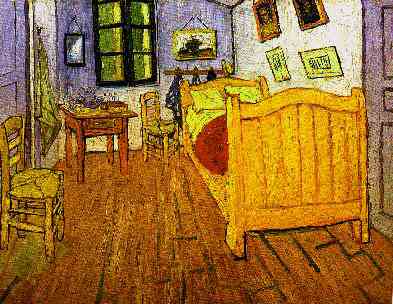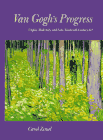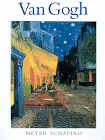Van Gogh: 1888--1890
Van Gogh's work represents the emotional spontaneity in painting. He attempted in his paintings a totality of human experience, such experience could not be conveyed in words but which could be expressed in line, colour and brushwork.
After cleaned his palette of muddy tones and insipid graduations of colour, he kept only the purest and crudest of tints, those highest in key, setting them down in abrupt but harmonious contrast. Van Gogh felt that each colour had quite a different meaning, possessed a spiritual value, symbolized the essence of being and carried a transcendent message. These ideas were applied to the Arles paintings.
The Sunflower series (1888-89) loaded with burden of meaning, is planned for the decoration purpose of his Yellow House. Each painting with a different background, letting the flowers expressed a range of mood, as he said: " Colour by itself describe something." The yellow, not only being descriptive is used expressively and it visualized feeling. Van Gogh considered it as the colour of faith, triumph or love. For "Bedroom in Arles" (1888), van Gogh depicted his room with a stark simplicity, using uniform patches of complementary orange and blue, yellow and violet, red and green. He wrote, "I wanted all these differentiate colours to express the totally restful feeling". The painting's emphasis on rest and sleep had been interpreted as a link to his unstable and exhausted state of mind; his description of it as "an empty room" bespeaks loneliness and desire for physical company.

above: Van Gogh, The Bedroom in Arles, 1888
In "The Night Cafe" (1888), van Gogh commented on the artificial light, to him, they had lost touch with personal and all humanity. The lamps added to the hopelessness of the atmosphere, render everything pitilessly and coldly. As van Gogh said: "I have attempted to express terrible human passions in red and greens. The room is blood red and a muted yellow, a green billiard table in the middle, and four lemon-yellow lamps casting orange and green light. Everywhere there are conflicts and antithesis".
" Portrait of Mme Roulin", portrayed Roulin as a uniformed representative of the State. The image is freshened by a sky blue ground framing the darker silhouette and accenting the yellow-gold braid of the uniform and Roulin's upthrust bearded face. This portrait visualized the sense of order and balance, by the organization of line, expression of the figure and his gesture.
Roulin's authority as State official is matched in the portrait by his status as father, he provided comfortable domestic order for his family.
In " Starry Night" (1889), van Gogh began to use the swirling brush strokes and intense yellows and blues. The swirling line give a sense of urgency, but the application of paint showed it was calculated and carefully painted. The mood of the painting is primarily conveyed by colours, shape and lines. The stars, which symbolized infinity and eternality, suggested hope and shine in darkness. "Starry Night" had also been interpreted as an expression for state of shock, the cypresses, olive tress, which are traditionally stand for mortality, along with the mountains had acted as van Gogh's catalyst.
Van Gogh's self portraits revealed a range of state of feelings and ideas. The "Self-portrait" (1889) showed a pale, craggy face of the painter sat against the blue-violet ground. Van Gogh is depicted with a dark blue painter's smock. The red-orange beard, knit brow, and clenched mouth at the centre of the composition insist on a determined presence and artistic temperament. This portrait visualized a sense of unease, explored the feeling of anxiety and loneliness.
Another "Self-Portrait" (1889), in which the face appeared firm, focused and determined. The orange-haired and bearded figure is set against a restless surface of swirling ice blue paint and the face has the familiar temperamental glare. The cool blue tones and curling brushstrokes infuse the picture with tension and energy; van Gogh challenges the viewer with his stare and is fiercely erect. This portrait generate the feeling of unease and anxiety of the viewers, they interacted with the unbalance quality of the dabs of colour. The circular swirls of brushwork spin outward, creating a jumpy movement and a dizzying effect, again generate the feeling of unease.
The famous "Dr Gachet", depicted Gachet with his head resting heavily on the hand, the arm propped on the elbow, the drooping eyelids and glum mouth, had been the stereotype image of melancholic. Set against a background of the most intense blue with restless staccato lines, the portrait of the doctor is built around the pale, penetrating eyes with their expression of deep sorrow. Gachet is shown as a melancholic, wearing of what Van Gogh called "the broken-hearted features of our times". Gachet emblematizes modernity's problems and disappointments.
The "Field under a Stormy Sky" (1890) and "Crows over the Wheatfields" (1890) achieved the most intense expressiveness through such sober means. "Field under a Stormy Sky" is one of van Gogh's most compelling simple compositions. Land and sky divided into two horizontal bands, depicted by two primary colours, blue and yellow, and the resultant secondary colour, green. The short, incisive brushstrokes are essential to the picture, creating and animating the surfaces.
"Crows over the Wheatfield", in an absolutely frontal treatment the wheat form a compact mass-produced by the thick crossed tangled of strokes applied. These paintings conveyed the expression of sorrow and loneliness, as van Gogh described them: "They are vast fields of wheat under troubled skies, and I did not need to go out of my way to try to express sadness and extreme loneliness". Bu they also meant for the re-generation, new and growth; the thick yellow symbolized hope and growth. As van Gogh once said, "íKthese canvases will tell you what I cannot say in words, the health and restorative forces that I see in the country".
Recommended Reading(s):



Back to top
Back to Home




